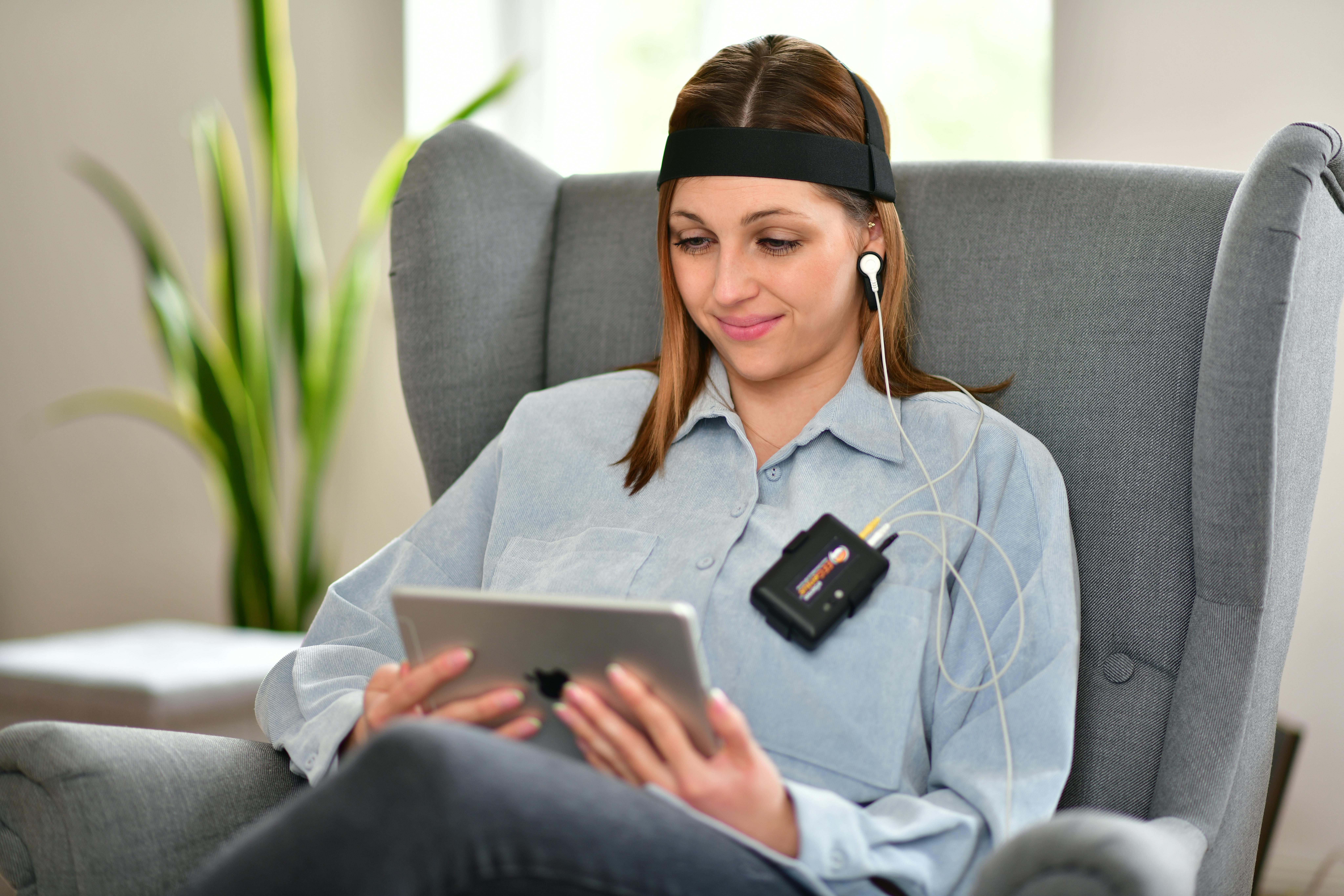Healing the Brain: How Neurofeedback and Trauma Recovery Go Hand in Hand
Filed in Mental Health — April 14, 2025

For millions of people, trauma isn’t something that exists only in memory. It lingers in the nervous system, shaping thoughts, emotions, and behaviors long after the original experience has passed. Trauma changes the brain—its patterns, its reactivity, and even its physical structure. But here’s the hopeful part: the brain is capable of change. One powerful and increasingly accessible method for facilitating this healing is neurofeedback. More specifically, remote neurofeedback has emerged as a practical, science-backed way to support recovery.
If you’re exploring options for healing—whether from childhood trauma, anxiety, PTSD, chronic stress, or emotional overwhelm—understanding the relationship between neurofeedback and trauma could be a critical step forward.
What Is Neurofeedback?
Neurofeedback is a form of biofeedback that uses real-time displays of brain activity—most often through EEG technology—to help individuals regulate their brainwaves. It’s a non-invasive, drug-free method that trains the brain to function more efficiently. Through visual or auditory cues, the brain receives instant feedback about its current activity and learns how to self-correct patterns that are dysregulated due to trauma or chronic stress.
You can think of neurofeedback as brain training. Much like physical therapy retrains injured muscles, neurofeedback retrains the brain, allowing it to move from patterns of hyperarousal or dissociation into a more balanced and resilient state. You can learn more with my free download, ‘Is Neurofeedback Therapy Right For You?’.
The Link Between Neurofeedback and Trauma
So why do neurofeedback and trauma recovery work so well together?
To understand this, it helps to know how trauma affects the brain. Research has consistently shown that traumatic experiences—especially chronic or early-life trauma—can alter brain activity in significant ways:
- The amygdala becomes hyperactive, increasing fear responses.
- The hippocampus, which helps process memory, becomes impaired.
- The prefrontal cortex, responsible for reasoning and emotional regulation, often becomes underactive.
These changes create a brain that is on high alert, quick to perceive threat, and slow to return to calm. Over time, this leads to symptoms such as anxiety, emotional dysregulation, insomnia, and a persistent sense of disconnection.
This is where neurofeedback becomes so relevant. By helping the brain learn to regulate itself in real time, neurofeedback offers a pathway to restore balance and function. The keyword phrase here—neurofeedback and trauma—represents not just a treatment pairing, but a dynamic healing relationship.

What the Research Says
Neurofeedback has been studied in clinical settings for decades, and the evidence supporting its efficacy in trauma recovery is strong and growing.
A landmark study published in Applied Psychophysiology and Biofeedback (2016) found that neurofeedback significantly reduced PTSD symptoms in combat veterans, a population with some of the most treatment-resistant forms of trauma. Participants reported improved emotional regulation, reduced flashbacks, better sleep, and overall improved quality of life.
Another review in Frontiers in Human Neuroscience (2021) highlighted that neurofeedback can modulate neural circuits affected by trauma, particularly in individuals who do not respond to traditional talk therapy or medication.
And for those considering remote options, the news is equally encouraging. A study in NeuroRegulation (2020) confirmed that remote neurofeedback, when guided by a qualified clinician, can deliver results comparable to in-office sessions. Clients participating from home reported high levels of satisfaction, reduced symptoms, and improved engagement.
Why Remote Neurofeedback Works
One of the most exciting developments in the field of neurofeedback and trauma is the emergence of remote neurofeedback. Using FDA-approved EEG devices and professional oversight, clients can now access high-quality neurofeedback training from the comfort of their own homes.
Here are several practical reasons why remote neurofeedback is an excellent choice for trauma recovery:
1. Accessibility
Transportation issues, time constraints, and childcare needs often keep people—especially women and caregivers—from getting the help they need. Remote neurofeedback eliminates these barriers, making healing more accessible for everyone.
2. Comfort and Safety
For trauma survivors, clinical settings can be overwhelming. Remote neurofeedback allows clients to engage in brain training in a setting where they already feel safe—home. This comfort can accelerate the healing process by reducing environmental stressors.
3. Consistency
Neurofeedback works best with regular sessions. When treatment is available at home, clients are more likely to stick with the program, increasing its effectiveness.
4. Customization and Support
Remote doesn’t mean you’re alone. With guided protocols, regular check-ins, and professional monitoring, remote neurofeedback can be just as personalized and supported as in-person care.
Who Benefits from Neurofeedback and Trauma Work?
Remote neurofeedback is appropriate for anyone struggling with symptoms related to trauma, such as:
- Anxiety and panic attacks
- Emotional numbness
- Sleep disturbances
- Hypervigilance
- Difficulty concentrating
- Mood swings
- Chronic stress and burnout
In my practice, I’ve seen neurofeedback change lives. Moms, professionals, survivors of abuse, people in recovery from addiction—all of them have experienced profound shifts. The most common feedback? “I finally feel like myself again.” You can learn all about my remote Neurofeedback Therapy program on my website, www.shelbyjohn.com.
Real Stories, Real Change
One of my clients—a woman in her 40s recovering from a high-conflict divorce and childhood neglect—described the impact of remote neurofeedback like this: “For the first time, I feel like my nervous system isn’t in overdrive. I can breathe. I can think. I don’t react like I used to.”
Another client, a busy mom of three juggling a demanding job and family obligations, noticed improvements in sleep and emotional reactivity within a few weeks. “It didn’t solve everything overnight, but it gave me a foundation. I stopped feeling like I was constantly on edge.”
These are just two examples of how neurofeedback and trauma healing go hand in hand.
Start Your Journey Today
If you’re ready to explore how neurofeedback and trauma healing can work for you, I invite you to take the first step. I’ve created a free resource to help you begin shifting your nervous system out of survival mode:
👉 Download Is Neurofeedback Therapy Right For You?
This guide includes practical steps to start feeling better right now and lays the foundation for deeper healing through neurofeedback and other nervous system-regulating tools.
Why Work With Me?
As a licensed therapist specializing in trauma, anxiety, and addiction, I bring years of clinical experience to the table. I also understand the practical challenges of being a woman, a mom, and a professional navigating life after trauma. My approach to remote neurofeedback is personalized, compassionate, and results-driven.
Visit shelbyjohn.com to learn more about my services, including how we can work together using remote neurofeedback. You’ll find detailed information about the process, pricing, and how to get started.
Final Thoughts
The connection between neurofeedback and trauma isn’t just theoretical—it’s transformational. This powerful combination has helped thousands of people reduce symptoms, restore peace of mind, and rebuild their lives.
If you’ve been feeling stuck, overwhelmed, or like talk therapy isn’t quite enough, remote neurofeedback might be the missing link.
You don’t have to carry the weight of trauma forever. Your brain can heal. Your nervous system can settle. And your life can feel hopeful again.
Let this be your turning point. Download your free guide, and take the next step toward lasting emotional freedom.


